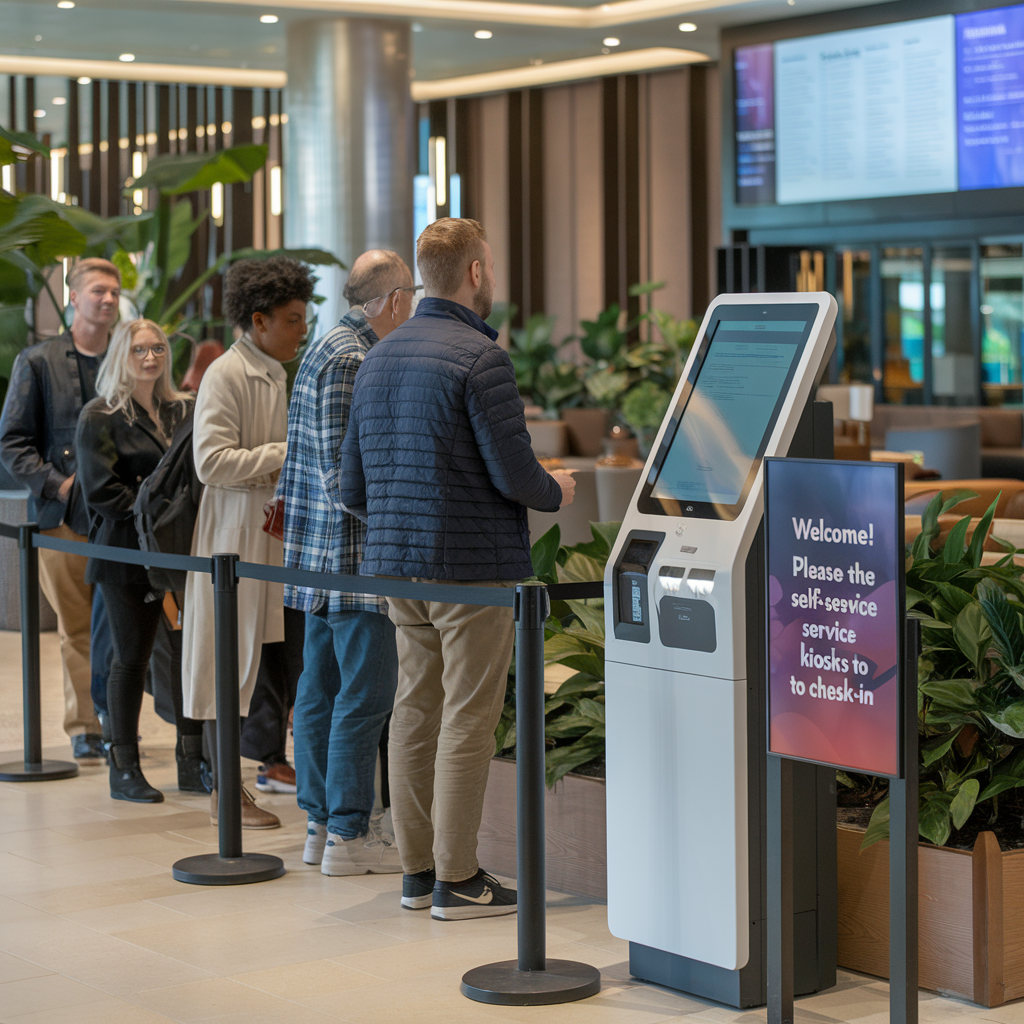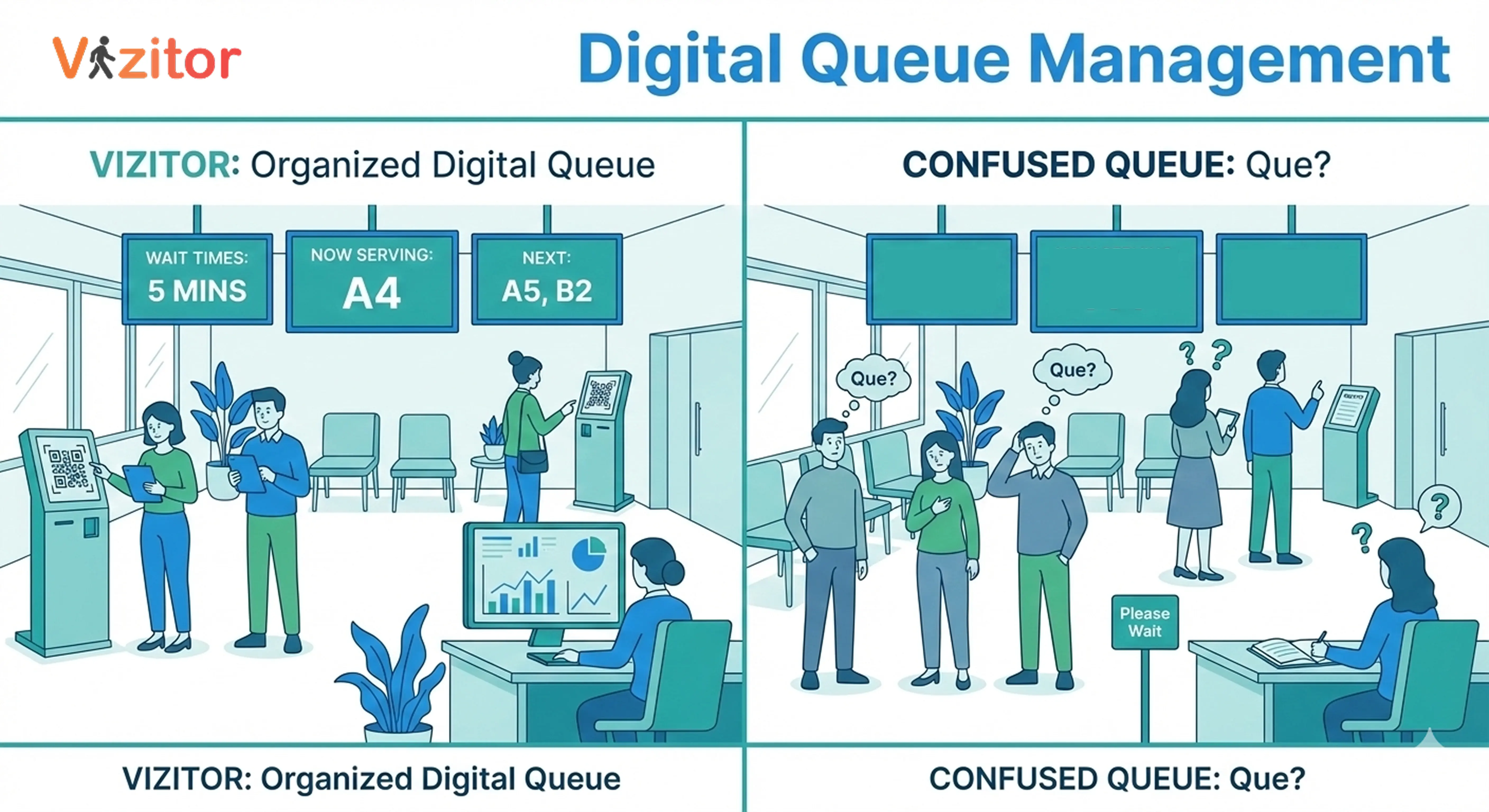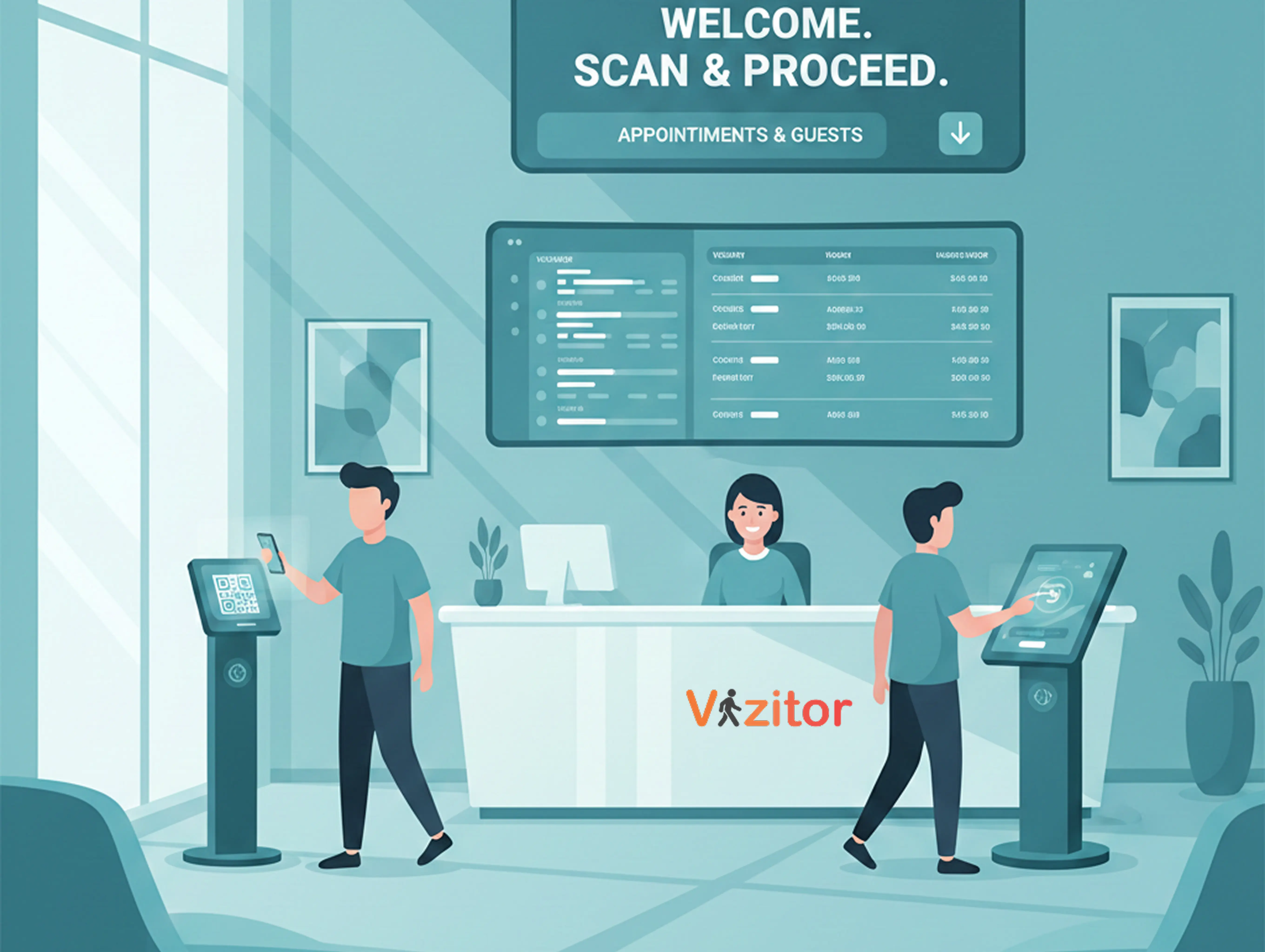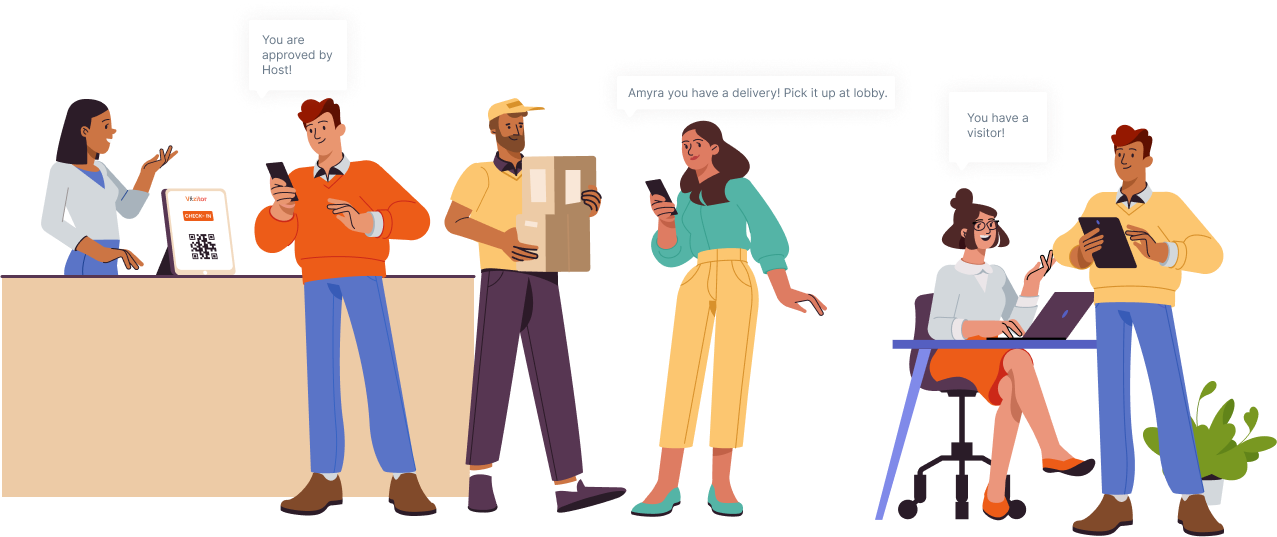How to reduce queue times with self-service kiosks
Long queues frustrate visitors and slow down operations. Self-service kiosks offer a smart solution by enabling faster check-ins, reducing wait times, and improving overall visitor flow. By integrating kiosks with a visitor management system, organizations can boost efficiency, enhance the guest experience, and free up staff to focus on more valuable tasks.
Table of Content
Try Vizitor for Free!

Published on: Sat, Nov 9, 2024
Last updated: Updated on 15/09/2025
Read in 8 minutes
In a world where customers expect fast, seamless service, self-service kiosks have emerged as a powerful tool for businesses to reduce queue times, improve service delivery, and enhance the overall customer experience. Whether it’s in retail, healthcare, banking, or restaurants, self-service kiosks are empowering customers to manage their service needs efficiently, cutting down wait times, and alleviating pressure on staff.
With solutions like Vizitor’s self-service kiosks, businesses can streamline operations, increase customer satisfaction, and optimize resources. Here’s an in-depth look at how self-service kiosks are transforming service experiences across various sectors, as well as how Vizitor’s technology stands out in this space.
What Are Self-Service Kiosks in Queue Management?
Self-service kiosks are digital check-in stations designed to streamline the visitor flow process and minimize wait times. Instead of waiting in long lines at a reception desk, visitors can quickly enter their details, scan an ID, or even generate a visitor pass directly at the kiosk.
In the context of Queue management, kiosks act as automated assistants, they:
- Register visitors in seconds.
- Assign digital or printed tokens to manage turn-taking.
- Display real-time queue updates to reduce anxiety.
- Integrate with visitor management systems for accurate tracking and reporting.
By digitizing these routine tasks, self-service kiosks not only reduce queue times but also improve workplace security and efficiency. They are widely used in offices, hospitals, government buildings, banks, and retail outlets where visitor flow is high and time management is critical.
Key Benefits of Self-Service Kiosks in Reducing Queue Times
Faster Service Through Autonomous Action
One of the main advantages of self-service kiosks is that they empower customers to complete tasks without waiting for assistance. For instance, a customer can check in at a kiosk, complete a transaction, or place an order, all of which would typically require an interaction with staff. A survey by ECR Retail Loss Group found that self-service kiosks reduce checkout times by 25%.
Reduced Workload for Staff
Self-service kiosks also reduce the workload on staff by handling repetitive tasks, such as order-taking or check-ins, freeing employees to focus on more complex customer interactions. As a result, staff can provide better, more personalized service, while the kiosks manage simpler tasks efficiently.
Better Resource Allocation
With kiosks handling routine tasks, businesses can allocate staff to areas where they’re needed most, creating a smoother, more efficient customer service experience. For example, McDonald’s reported a 20% increase in efficiency by using self-service kiosks, as it allowed staff to focus on food preparation and customer support.
How Self-Service Kiosks Improve the Customer Experience
Increased Control for Customers
Self-service kiosks give customers control over their experience, allowing them to manage their own time and complete tasks at their own pace. According to a survey by PYMNTS.com, 60% of customers prefer self-service options because it offers them a sense of control over the process.
Enhanced Accuracy and Customization
Kiosks reduce human error, as customers can input their information directly and make choices according to their preferences. For instance, in fast-food settings, customers can customize their orders to their liking, which enhances satisfaction and ensures accuracy.
Shorter Perceived Wait Times
Even if a customer has to wait briefly for a kiosk, the active engagement in selecting options and completing tasks makes the wait feel shorter. This engagement leads to a 35% reduction in perceived wait times, as reported by QSR Magazine.
Industry Applications of Self-Service Kiosks
Self-service kiosks are transforming the way organizations handle visitor check-ins, queue management, and customer interactions. Their versatility makes them suitable across multiple industries where efficiency and experience are top priorities.
Corporate Offices
In busy workplaces, kiosks streamline visitor check-ins, issue digital badges, and notify hosts instantly, reducing reception desk load and enhancing security.
Healthcare Facilities
Hospitals and clinics use kiosks for patient registration, appointment check-ins, and queue management. This reduces overcrowding in waiting areas and speeds up access to doctors and services.
Retail & Shopping Malls
Kiosks guide customers, offer self-checkout options, and provide real-time promotions, ensuring faster transactions and a smoother shopping experience.
Banks & Financial Institutions
Self-service kiosks handle token generation, queue management, and appointment scheduling, improving customer satisfaction and reducing operational bottlenecks.
Government Offices
From passport offices to municipal services, kiosks minimize long queues, automate visitor entry, and help citizens access services more efficiently.
Hospitality Industry
Hotels and event venues use kiosks for self-check-ins, ticket scanning, and guest registrations, allowing staff to focus on delivering a better guest experience.
By automating repetitive tasks across industries, self-service kiosks save time, cut costs, and enhance user experiences, making them an essential part of modern visitor management.
How Vizitor’s Self-Service Kiosks Lead the Way
Vizitor’s self-service kiosk solutions are designed to enhance customer experiences while reducing operational complexities. With intuitive interfaces, customizable features, and seamless integrations, Vizitor’s kiosks provide an all-in-one solution for queue management.
Customizable Interface
Vizitor’s self-service kiosks can be customized to display your brand’s logo, colors, and specific instructions, ensuring a cohesive brand experience. This customization is valuable for retail and healthcare settings, where different services require tailored customer instructions.
Integration with Other Vizitor Solutions
Vizitor’s kiosks integrate with our other services, such as digital signage and mobile notifications, for a complete queue management system. For example, customers can receive updates on their mobile devices after checking in at a kiosk, creating a seamless multi-channel experience.
Real-Time Data and Analytics
Vizitor provides real-time data on customer flows, wait times, and kiosk usage, allowing businesses to make informed decisions. Analytics can help identify peak hours and optimize staff deployment, leading to better resource management.
Easy-to-Use, Multilingual Interface
Vizitor’s kiosks are designed to be accessible to diverse audiences, with multilingual options and user-friendly interfaces. This inclusivity ensures that everyone can navigate the system, improving the experience for a wide customer base.
Affordable compared to competitors
Vizitor provides enterprise-level features at cost-effective pricing, making advanced kiosk solutions accessible to businesses of all sizes.
Case Studies: Vizitor’s Kiosks in Action
Case Study 1: Retail Store
A large retail chain implemented Vizitor’s self-service kiosks to manage queues during peak shopping seasons. Customers were able to sign up for loyalty programs and check out independently, reducing average wait times by 30%. The store reported a 15% increase in customer satisfaction as well as a boost in repeat visits.
Case Study 2: Healthcare Facility
A busy healthcare facility installed Vizitor’s self-service kiosks to streamline patient check-ins and reduce congestion. Patients were able to check in, update insurance information, and even make payments, all through the kiosks. The facility reported a 25% reduction in waiting room occupancy and an improvement in patient satisfaction scores.
The Future of Self-Service Kiosks in Queue Management
AI-Driven Kiosks for Personalized Service
The future of kiosks includes AI capabilities that provide personalized services based on customer data. For instance, an AI-powered kiosk could remember a customer’s previous orders or preferences, creating a more customized experience.
Voice-Activated Kiosks
Voice-activated kiosks are also on the rise, making the interaction hands-free and more accessible. This technology is especially beneficial in healthcare and hospitality settings, where customers may have limited mobility.
Biometric Integration
In high-security industries like banking and healthcare, kiosks with biometric features, such as fingerprint or facial recognition, enhance security and streamline the process for returning customers.
Implementing Vizitor’s Self-Service Kiosk for Your Business
Starting with Vizitor’s self-service kiosks is simple:
- Sign Up for a Free Trial: Click here to try Vizitor for free and experience our kiosk features firsthand.
- Customize Your Kiosk: Tailor the look and functionality of your kiosks to meet your specific service needs and brand guidelines.
- Monitor and Optimize: Use Vizitor’s analytics dashboard to monitor kiosk performance, wait times, and customer engagement, and make data-driven improvements.
Success Tips for Effective Kiosk Implementation
Position Kiosks Strategically
Place kiosks in high-traffic areas or where queues commonly form, such as near entrances or check-out points, to maximize their usage.
Provide Clear Instructions
Ensure that customers know how to use the kiosks by providing clear instructions or staff assistance during the initial rollout.
Regular Maintenance and Updates
Keep kiosks in optimal condition by scheduling regular maintenance checks and updating software to incorporate new features or improve security.
Conclusion
Self-service kiosks are revolutionizing how businesses handle queues, enabling faster, more efficient service delivery across industries. By empowering customers to take control of their service experience, kiosks reduce queue times, free up staff, and boost overall satisfaction. Vizitor’s self-service kiosk solution offers a customizable, easy-to-use, and data-driven approach to queue management, making it a valuable tool for businesses aiming to improve service efficiency.
Ready to see the impact of self-service kiosks on your business?
Sign up for a free trial with Vizitor today and discover how our kiosk solution can optimize your queue management and elevate your customer experience.
FAQs About Self-Service Kiosks
1. Do self-service kiosks really reduce queue times?
Yes, Studies show kiosks can cut queue times by up to 25-30%, helping businesses serve more customers in less time.
2. Are self-service kiosks affordable for small businesses?
Absolutely. Solutions like Vizitor are designed to be cost-effective, offering scalable features without heavy upfront investment.
3. How do kiosks improve customer satisfaction?
By reducing wait times, enabling customization, and providing accuracy, kiosks give customers more control and faster service.
4. What industries benefit most from self-service kiosks?
Retail, healthcare, hospitality, education, and banking all benefit by streamlining processes and improving the customer experience.
5. How is Vizitor different from other kiosk providers?
Vizitor combines customizable branding, real-time analytics, affordability, and seamless integration, making it one of the most reliable and user-friendly options available.









